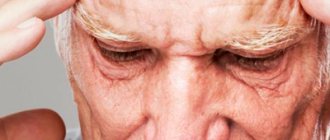Clinical effectiveness of the drug Rexetine (paroxetine) for anxiety spectrum disorders
Rumyantseva G.M., Stepanov A.L., Levina T.M., State Scientific Center for Social and Forensic Psychiatry named after. V.P. Serbsky, Moscow
Introduction
Anxiety-phobic disorders are among the most common mental disorders encountered in general medical practice (A.B. Smulevich, 1999).
The higher prevalence of anxiety spectrum disorders among the population compared to depressive disorders was also revealed in large epidemiological studies conducted in the last decades of the last century (D. Regier et al., 1998).
Anxiety and depression, according to a number of scientists, are not independent diseases, but only stages in the development of a single affective pathology, in which anxiety is a more adaptive manifesting syndrome (H. van Praag, 2000).
In the structure of anxiety spectrum disorders, phobic, obsessive, hypochondriacal, compulsive and other symptoms that are part of the anxiety syndrome or comorbid disorders often occupy a significant place.
In the process of studying the contingent of people turning to private medical centers specializing in the treatment of borderline mental disorders, it was revealed that anxiety-phobic disorders occupy one of the first places among the reasons for seeking help (F40-F48 ICD-10).
At the same time, a certain specificity of the content of phobic manifestations was noted. Patients experience difficulties in expressing/verbalizing their fears, since their content could be morally condemned, incomprehensible to others, regarded as a sign of a serious and dangerous mental illness, for example, fear of harming a child or another loved one, fear of possible pregnancy and childbirth, fear of infection venereal disease, fear of homosexual attraction and/or the possibility of such contacts, fear of not being able to resist urination or defecation in a public place, etc.
As a rule, patients, suffering for a long time from their painful experiences, were afraid to go to medical institutions and hid their fears from others, often resorting to the help of psychics, removing the evil eye and damage, or religious rituals. In cases where anxiety became severe or comorbid disorders (somatoform and depressive) were added, they sought help in private medical centers, where, in their opinion, medical confidentiality is better maintained, anonymity is guaranteed and greater attention, support and care from the doctor are possible.
Such conditions are most often regarded as specific (isolated) phobias. However, at the time of contacting a specialist, the phobia, as a rule, is accompanied by a pronounced affect of anxiety and often comorbid depressive, somatoform manifestations, and panic disorder. This study is devoted to a clinical study of the effectiveness of treatment of these disorders with an antidepressant from the group of selective serotonin reuptake inhibitors (SSRIs) Rexetine.
Materials and methods
Under our supervision were 20 sick women aged 25-37 years, whose condition could be assessed within the framework of the ICD-10 rubric F40.2 - isolated phobias.
All patients had higher or incomplete higher education; 3 had two higher educations. 18 patients were married or living together; 13 of them had children.
At the time of treatment, patients complained of obsessive experiences of contrasting content: in 11 people it was the fear of harming a child or husband, which was usually accompanied by a fear of sharp, piercing objects.
In 7 of these patients, the primary phobia was supplemented by the fear of going crazy and/or, having lost control of oneself, committing a ridiculous action: screaming, hitting, losing consciousness and being left without help, not being able to hold back urination.
3 patients had an obsessive fear of sexual attraction to members of the same sex.
In 6 patients, it was the fear of pregnancy and the possibility of carrying it to term due to the “state of their health” and the consequences for the “mental usefulness” of the unborn child.
The onset of phobic disorders in all patients is between the ages of 20-27 years.
In a clinical study, it was determined that half of the premorbid patients were close to accentuated personalities with anxious and anancastic character traits, prone to increased anxiety, responsibility, hypernormativity, doubts and fears, mainly of hypochondriacal content. Typically, these patients showed a tendency to obsessive fears regarding their health already in childhood. As a rule, these features became sharper after emotional shocks (serious illness and death of a close relative or peer, alcoholism of one of the parents, situations where children witnessed an accident or were exposed to the threat of violence).
The remaining patients did not have pronounced character accentuations and were distinguished by activity, purposefulness and were socially successful.
Their fears arose against the background of a long-term psychologically traumatic situation (disharmony in family or partner relationships, conflict at work) or shortly after acute stressful experiences (attack and violence, death of the first child, forced abortion, miscarriage, breakup).
The aggravation of painful manifestations occurred gradually either due to the addition of obsessions of other (hypochondriacal) content (fear of madness, stroke/heart attack, cancer), or due to increased anxiety and the appearance of depressive syndromes.
Despite the complexity of the clinical picture, the diagnosis of a specific phobia always came first, since for a long time the disease was limited only to these symptoms. Were comorbid in
In 9 cases there was panic disorder (F41.0), in 11 cases there was mixed anxiety-depressive disorder (F41.2).
Panic disorder occurred at the height of obsessive fears (for example, harming a child, losing consciousness on the street, on the eve of medical examinations). The structure of panic disorder included pronounced fear, bodily tension, vegetative-vascular and somatic components. The frequency and severity of panic attacks were insignificant, the conditions did not require emergency medical care, and patients coped with panic symptoms on their own or with the help of loved ones. In all patients, sleep was disturbed, dreams acquired a painful, anxious, depressing character. Avoidance behavior developed: patients stopped visiting places where there were sharp and piercing objects, subways, elevators, closed spaces, and avoided air travel.
In cases of the development of mixed anxiety-depressive disorder, the patients' condition was characterized by increased generalized anxiety. At the same time, there were equally somatic and mental components of anxiety. Then a depressed mood followed with irritability, insomnia, anhedonia, decreased appetite, and progressive loss of body weight.
The Hamilton Anxiety and Depression Scale and the Sheehan Phobia Scale were used to examine the patients.
All patients were prescribed rexetine (paroxetine) at an initial dose of 20 mg. The dose was increased to 40 mg as indicated after 1 week. 3 patients and at the 4-5th week of treatment in another 5 patients. During treatment, the patients did not change their usual life schedule and did not lose their ability to work.
In the 1st week of treatment, all patients received benzodiazepines (alprazolam, clonazepam) to correct acute feelings of anxiety, restlessness and characteristic insomnia. The dose was reduced and benzodiazepines were discontinued gradually by the end of the 2nd week.
The total duration of treatment was 5 weeks.
Results and discussion
The most sensitive to the effects of rexetine was the anxiety symptom complex.
Thus, already in the 1st week of treatment, some patients began to notice a decrease in bodily tension and feelings of internal trembling, sweating, the intensity of the feeling of incomplete inspiration decreased, and there was a tendency to improve sleep.
During the 2nd week, the regression of anxiety was more significant: influxes of painful thoughts and images of the main phobic experience (fear of going crazy/losing control, causing harm, etc.) were less intense and more rare; daily mood swings became less severe; manifestations of dissatisfaction, hostility and irritation towards the immediate environment softened.
It should be noted that the therapeutic effect occurs quite quickly. The most pronounced decrease in the intensity of anxious experiences and improvement in the well-being of patients was observed during the first 4 weeks. therapy with rexetine. Subsequently, the positive dynamics slowed down somewhat and became more gradual.
A decrease in the intensity and burden of the “mental chewing gum” followed after 2-3 weeks. along with a decrease in overall affective tension (sensual charge of experiences). Normalization of well-being to the initial, pre-painful state was observed starting from the 3-4th week of treatment.
Depressive symptoms began to reverse most significantly after 3 weeks. treatment: at first, patients reported a decrease in the constant feeling of weakness and fatigue, an increase in strength and the emergence of desires and interest in life. At this time, emotional revival and a decrease in motor and mental retardation were observed. There was also a reduction in anhedonic complaints (lack of pleasure from communication, sex, food, reading, creative hobbies, work; a feeling of apathy). By this time, the vegetative stabilizing effect of the drug appeared.
Patients (4 people) noted a decrease in the frequency of gastrointestinal discomfort: senestalgia in the intestinal area, belching with air, gas formation, morning diarrhea and the urge to urinate before leaving the house.
The dynamics of essential phobic manifestations should be especially emphasized.
If the first 2 weeks. the improvement was mainly due to the reduction of the anxiety symptom complex, then in the 3rd week of therapy a decrease in the frequency of occurrence of phobic experiences was noted. Patients could not remember their fears for most of the day; they appeared sporadically in the morning and evening hours. The strength of obsessive fears also decreased; they arose “on the periphery of consciousness,” without completely absorbing the patients’ attention. The most intense reduction was observed in the fear of madness, which was most closely associated with anxious affect. The lowest dynamics were noted for pregnancy phobia. The fear of causing harm to loved ones occupies an intermediate position in terms of therapeutic lability.
An almost complete reduction of phobias was achieved in 5 patients in whom the structure of the syndrome was complicated by a mixed anxiety-depressive disorder. In 12 patients, it was noted that the remaining phobic experiences were not emotionally saturated and were a “pale shadow” of those that existed before treatment. In 3 patients, despite the positive dynamics of painful symptoms, phobias remained unchanged, only their affective intensity decreased.
By the 4-5th week of treatment, 5 patients began to experience a “freezing” of the clinical picture - the absence of further positive dynamics, which required increasing the dose of the drug to 40 mg per day.
The most resistant to therapy remained the personal characteristics of patients: uncertainty, resentment, experience of one’s own imperfection, high personal anxiety. These experiences in most patients were long-term, latent, associated with the personality structure, and the patients adapted to them.
It should be noted that the majority of the patients we treated did not note the effect of excessive activation, “excitement,” restlessness and increased anxiety in the 1st week of treatment, characteristic of some SSRIs (fluoxetine, Paxil).
In the 1st week of treatment, 8 patients still reported increased difficulty falling asleep, frequent awakenings and greater irritability, which required the prescription of tranquilizers.
In 5 patients during the 1st and 2nd weeks. treatment, an increase in the phenomenon of sweating and a feeling of heat was noted, especially with excitement and when staying in stuffy rooms.
In no case did we observe neuroleptic symptoms (hypertonicity and hyperkinesis of the facial muscles and tongue, tremor, etc.) and significant phenomena of behavioral toxicity, as well as dysuria (given the fact that the sample of patients was female). However, 1 patient with a significant decrease in body weight (46 kg) and dysmenorrhea required a reduction in the dose of rexetine to 10 mg per day for 2 weeks. at the beginning of treatment.
Conclusion
The use of rexetine in dosages of 20-40 mg for isolated phobias with comorbid panic disorder (F41.0) and mixed anxiety-depressive disorder (F41.2) revealed the high effectiveness of the drug in relieving symptoms of anxiety and depression, as well as a pronounced antiphobic effect of paroxetine, which was shown in earlier works (S.N. Mosolov et al.).
The drug significantly alleviates the condition of patients, reduces the intensity and frequency of obsessive and phobic manifestations and improves the quality of life of patients. The distinct anxiolytic properties of rexetine with good tolerability make it possible to recommend it for use in outpatient practice for the treatment of isolated phobias with comorbid manifestations of panic disorder and mixed anxiety-depressive states.
References 1. Smulevich A.B., Ivanov S.V., Dubnitskaya E.B., Drobizhev M.Yu. // Smulevich A.B. Depression in general medical practice. - M.: Bereg, 2000. - P. 65-72. 2. Mosolov S.N., Smulevich A.B., Nuller Yu.L. and others. Use of the drug Paxil (Paroxetine) in the treatment of panic disorder (results of a Russian multicenter study). - M., 2003. 3. Praag HM van. Nosologomania: a disorder of psychiatry // World J. Biol. Psychiatry. - 2000. - 1. - 151-8. 4. Regier DA et al. Prevalence of anxiety disorders and their comorbidity with mood and addictive disorders // Br. J. Psychiatry. - 173 (Suppl. 34). - 24-8.
Who should take an antidepressant?
First of all, I want to write that I am not crazy. For some reason, many people, when they see “psychotropic” mentioned in the description of a drug, immediately imagine a schizophrenic or something else “more fun.” In fact, antidepressants help with many health problems, in particular treating sleep disorders.
Rexetine was recommended to me to suppress my fear of large crowds of people. Nothing terrible, but I really wanted to get rid of the panic that arises from concert halls, cinemas and other public places.
I went to the doctor. The specialist conducted testing and reported that I suffer from a mild form of agoraphobia. He said that this condition can be controlled by taking pharmacological drugs that affect the central nervous system. In particular, the doctor advised to pay attention to Rexetine.
“Don’t think that your problem is isolated.
Several dozen people come to me every day complaining of a fear of closed spaces and other phobias. Start treatment with a course of Rexetine. These pills are great for relieving panic. At least, reviews from my patients confirm the effectiveness of the drug" Oleg Efimovich, neurologist, psychiatrist, Moscow
I received a prescription, but before purchasing it I decided to make sure that the specialist prescribed the correct treatment. I went online and found out that Rexetine is indeed recommended for various panic conditions, prolonged depression, obsessiveness syndrome, and stress-related mental disorders.
How and why Rexetine works
I bought a package of the drug at the pharmacy and decided to study the instructions first. To be honest, I understood little from the description. Probably the terms are intended for specialists or chemists. In simple terms, the main component of Rexetine is paroxetine. This element is able to increase the concentration of serotonin in the central nervous system. Thus, improving mood and normalizing sleep. I read that many men even have their libido restored)))
I scrolled through the browser a little, looking for reviews from ordinary people about the drug. I read a lot of good things. It turns out that Rexetine has quite strong psychostimulating properties.
After taking the pills, the proper activity of brain cells is normalized and anxiety is significantly reduced. I was a little worried about side effects, but it turned out that the drug is metabolized in the liver and is excreted in equilibrium through urine and feces.
Contraindications and analogues of the drug
Separately, I would like to highlight possible restrictions on taking an antidepressant. Unfortunately, there are quite a few contraindications due to the large list of side effects. I did not experience any complications during the treatment, but in the reviews there were often references to sleep disturbances, dizziness, and increased sweating. There were also records of allergic reactions. Some people have reported hives, swelling, itching and burning of the skin.
The ban on treatment with Rexetine applies to:
- pregnant women;
- young mothers feeding their babies with breast milk;
- children (under 18 years old);
- people suffering from severe pathologies of the kidneys and liver.
If you are at risk or experience side effects, immediately consult a doctor. I think a specialist can find analogues of the tablets. For example, Plizil, Paxil or Adepress.
Reviews from buyers of the drug
I was worried that I might get hooked on pills. Movies constantly show that antidepressants are like drugs and are very difficult to give up. The doctor reassured me, saying that Rexetine is not addictive. I decided to make sure of this and look for other people’s reviews of my medicine.
“I am very glad that I found these pills. I have VSD (vegetative-vascular dystonia). For people unfamiliar with this disease, I will write that the main symptoms are a surge in blood pressure and panic attacks against this background. Rexetine really calms and relaxes. I took the course and haven’t had any problems with blood pressure for 6 months. I haven’t noticed any addiction, at least I don’t have any desire to constantly take the drug...”
A lot of reviews concerned seizures associated with VSD. I do not suffer from such a disease, but I think that this is an indicator of the effectiveness of the medicine. I know that dystonia is difficult to control, and if Rexetine succeeds in this, then we can hope for a good result with other diseases.
“I treated my husband with Rexetine. He became depressed after experiencing severe emotional overload. Don't think that mental fatigue is just inconvenient. A couple of times even an ambulance was called for attacks of tachycardia. The antidepressant really helped. Two weeks and my man began to smile at least sometimes and is gradually returning to normal life...”
Good reviews strengthened my confidence in the correctness of the prescribed treatment. I decided for myself that in a few months I would definitely stop being afraid of crowds and go to some interesting film in the cinema.









